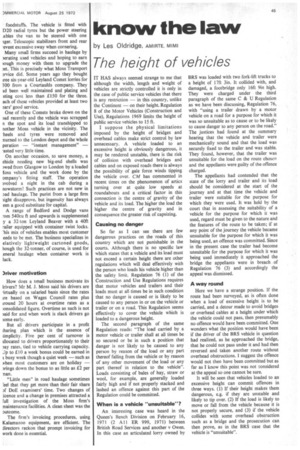know the law
Page 47

If you've noticed an error in this article please click here to report it so we can fix it.
by Les Oldridge, AMIRTE, MIMI
The height of vehicles
IT HAS always seemed strange to me that although the width, length and weight of vehicles are strictly controlled it is only in the case of public service vehicles that there is any restriction in this country, unlike the Continent — on their height. Regulation 8 of the Motor Vehicles (Construction and Use), Regulations 1969 limits the height of public service vehicles to 15 ft.
I suppose the physical limitations imposed by the height of bridges and overhead cables make strict control by law unnecessary. A vehicle loaded to an excessive height is obviously dangerous, it may be rendered unstable, there is the risk of collision with overhead bridges and cables and on exposed roads there is always the possibility of gale force winds tipping the vehicle over. CM has commented in recent times on the phenomenon of artics turning over at quite low speeds at roundabouts and a critical factor in this .connection is the centre of gravity of the vehicle and its load. The higher the load the higher the centre of gravity and in consequence the greater risk of capsizing.
Causing no danger So far as I can see there are few dangerous practices on the roads of this country which are not punishable in the courts. Although there is no specific law which states that a vehicle and its load must not exceed a certain height there are other regulations which will deal effectively with the person who loads his vehicle higher than the safety limit. Regulation 76 (1) of the Construction and Use Regulations requires that motor vehicles and trailers and their loads must at all times be in such condition that no danger is caused or is likely to be caused to any person in or on the vehicle or trailer or on a road. This Regulation seems effectively to cover the vehicle which is loaded to a dangerous height.
The second paragraph of the same Regulation reads: "The load carried by a motor vehicle or trailer shall at all times be so secured or be in such a position that danger is not likely to be caused to any person by reason of the load or any part thereof falling from the vehicle or by reason of any other movement of the load or any part thereof in relation to the vehicle". Loads consisting of bales of hay, straw or wool, for example, are generally loaded fairly high and if not properly stacked and lashed an offence against this part of the Regulation could be committed.
When is a vehicle "unsuitable"?
An interesting case was heard in the Queen's Bench Division on February 16, 1971 (2 All ER 999, 1971) between British Road Services and another v Owen. In this case an articulated lorry owned by BRS was loaded with two fork-lift trucks to a height of 17ft 3in. It collided with, and damaged, a footbridge only 16ft 9in high. They were charged under the third paragraph of the same C & U Regulation as we have been discussing, Regulation 76, with "using a trailer drawn by a motor vehicle on a road for a purpose for which it was so unsuitable as to cause or to be likely to cause danger to any person on the road." The justices had found at the summary hearing that the vehicle and trailer were mechanically sound and that the load was securely fixed to the trailer and was stable. They found, however, that the trailer was unsuitable for the load on the route chosen and the appellants were guilty of the offence charged.
The appellants had contended that the state of the lorry and trailer and its load should be considered at the start of the journey and at that time the vehicle and trailer were suitable for the purpose for which they were used. It was held by the court that in assessing the suitability of a vehicle for the purpose for which it was used, regard must be given to the nature and the features of the route to be taken; if at any point of the journey the vehicle became unsuitable for the purpose for which it was being used, an offence was committed. Since in the present case the trailer had become unsuitable for the purpose for which it was being used immediately it approached the bridge the appellants were in breach . of Regulation 76 (3) and accordingly the appeal was dismissed.
A way round Here we have a strange position. If the route had been surveyed, as is often done when a load of excessive height is to be carried, and a detour made to avoid bridges or overhead cables at a height under which the vehicle could not pass, then presumably no offence would have been committed. One wonders what the position would have been if the driver of the BRS vehicle in question had realized, as he approached the bridge, that he could not pass under it and had then reversed and taken another route without overhead obstructions. I suggest the offence would not then have been committed but as far as I know this point was not considered at the appeal so one cannot be sure.
It will be seen that vehicles loaded to an excessive height can commit offences in three ways. (1) If their height makes them dangerous, e.g. if they are unstable and likely to tip over. (2) If the load is likely to move or fall from the vehicle because it is not properly secure, and (3) if the vehicle collides with some overhead obstruction such as a bridge and the prosecution can then prove, as in the BRS case that the vehicle is "unsuitable".




















































































